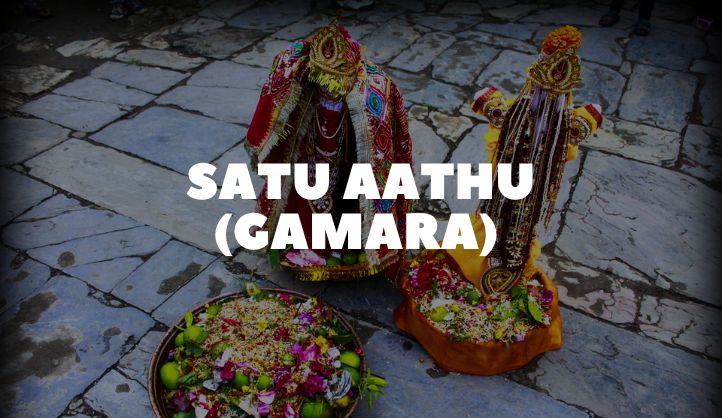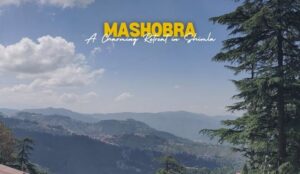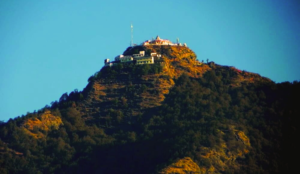Uttarakhand, a state renowned for its breathtaking landscapes and rich cultural heritage, comes alive with vibrant yearly festivals. One such celebration, steeped in tradition and brimming with joy, is the Satu Aathu (also known as Gamara) festival. This unique event, observed primarily in the Kumaon region, particularly in the district of Pithoragarh, is a week-long extravaganza dedicated to celebrating the divine union of Lord Shiva and Parvati.
The Story Behind Satu Aathu
Several fascinating legends surround the origin of Satu Aathu. The most popular narrative revolves around the celestial love story of Shiva and Parvati. As the tale goes, Parvati, upset with Shiva, leaves her abode and returns to her parents’ home. Filled with remorse, Shiva embarks on a journey to win her back. This week-long period of reconciliation forms the essence of the Satu Aathu festival.
Another legend associates the festival with the worship of Gaura (Gauri), another name for Parvati, and her consort Maheshwar (Shiva). Here, the focus lies on celebrating Gauri’s homecoming after a visit to her parents’ place.
A Week-Long Celebration
Satu Aathu unfolds over seven days, each marked by specific rituals and traditions. Here’s a glimpse into the captivating journey of this festival:
Biruda Panchami
The festivities commence on the auspicious day of Biruda Panchami, which falls on the fifth day of the bright fortnight (Shukla Paksha) in the Hindu month of Bhadra (August-September). This day signifies the beginning of preparations for Gauri’s arrival. Women gather and clean their homes, symbolizing a fresh start.
Preparation and Fasting
The following days are dedicated to preparing special offerings and maintaining a strict fast by women. Homes are adorned with colorful rangolis (decorative patterns), and a special flour mixture called “Saatu” (made from roasted barley or wheat) is prepared. This “Saatu” is used for various rituals and offerings throughout the festival.
Jhora and Nyoli Nights
As dusk descends on the third and fourth days, the air fills with the melodies of traditional folk songs. Women, dressed in their finest attire, gather in courtyards or open spaces to sing vibrant songs called “Jhora” and “Nyoli.” These soulful renditions narrate various stories from Hindu mythology, particularly focusing on the love story of Shiva and Parvati. The rhythmic beats of the “Dhol” (drum) and “Hurka” (a string instrument) add a captivating touch to the evenings.
Bhaganola and Gamara
The fifth day witnesses a surge in enthusiasm. A special clay structure called “Bhaganola” is created, symbolizing Gauri. Women sing and dance around the “Bhaganola,” offering prayers and seeking blessings for a happy married life. This day also marks the commencement of the “Gamara” ceremony, where women enact scenes depicting Gauri’s preparations to return to her husband’s abode.
Culmination and Immersion
The festive week reaches its pinnacle on the seventh day. The “Bhaganola” is immersed in a nearby river, signifying Gauri’s departure and the reunion of Shiva and Parvati. This final day is often marked by a celebratory feast where families gather and relish delectable delicacies.
The Essence of Satu Aathu
Satu Aathu transcends mere festivities, it’s a vibrant tapestry woven with cultural threads. Here’s what makes this festival truly special:
Celebration of Femininity
Satu Aathu primarily revolves around women. It empowers them through shared experiences, fostering a sense of community and togetherness.
Transmission of Tradition
The festival plays a crucial role in passing down generations-old traditions, folklore, and folk music to younger generations.
Harmony with Nature
The use of natural elements like “Saatu” and immersion of the “Bhaganola” in the river underscores the festival’s connection with nature.
Social Bonding
Satu Aathu strengthens social bonds within the community. The collective preparation, singing, and rituals create a sense of unity and belonging.
A Guide for Travelers
If you seek an immersive cultural experience, experiencing the Satu Aathu festival firsthand is an unforgettable journey. Here are some pointers for travelers:
-
Timing: The festival typically falls in the month of August or September. Confirm the exact dates closer to the time of your visit.
-
Location: The heart of the celebrations lies in the Pithoragarh district of Uttarakhand. However, variations of the festival are observed in other parts of the Kumaon region as well.
- Accommodation: Pithoragarh offers a range of accommodation options, from budget-friendly guesthouses to comfortable hotels. Booking in advance, especially during peak season, is recommended.
- Respecting Traditions: As a visitor, it’s crucial to dress modestly and be respectful of the local customs and traditions. Observe from a distance and avoid interrupting rituals.
- Experiencing the Culture: Engage with locals and learn about the significance of the festival. Consider attending workshops on folk music or dance to gain a deeper understanding.
- Souvenir Shopping: Look for local handicrafts and traditional attire as souvenirs. Support local artisans and businesses.
A Symphony of Sounds and Sights – Capturing the Essence
The sights and sounds of Satu Aathu are truly captivating. Here’s what you can expect:
-
Visual Spectacle: Witness women dressed in vibrant attire, adorned with traditional jewelry. The colorful “rangolis” and the intricately designed “Bhaganola” add to the visual feast.
-
Melodious Harmony: Immerse yourself in the soulful melodies of “Jhora” and “Nyoli” songs. The rhythmic beats of the “Dhol” and “Hurka” create an unforgettable soundscape.
-
Festive Delights: Savor the unique culinary delights prepared during the festival. Sample local delicacies like “Bhang ki Chutney” (cannabis chutney) and “Kumaoni Bhatt ki Curry” (black lentil curry).
Some Other festivals Celebrated in Uttrakhand
Kumbh Mela
Arguably the grandest Hindu pilgrimage and festival, the Kumbh Mela is a sight to behold. Held every 12 years in Haridwar, it attracts millions of devotees seeking spiritual purification by bathing in the holy Ganges River.
Basant Panchami
Marking the arrival of spring, Basant Panchami is a festival dedicated to Saraswati, the Hindu goddess of knowledge and arts. People wear yellow attire, symbolizing the season’s vibrancy, and offer prayers for academic and artistic success.
Phool Dei
Phool Dei is a charming springtime festival, primarily observed in the Garhwal and Kumaon regions, which welcomes the blossoming season. Young girls collect fresh flowers and offer them at houses and temples, seeking blessings and prosperity for the year ahead. In return, they receive sweets and small gifts.
Uttarayani (Makar Sankranti)
Coinciding with Makar Sankranti, Uttarayani marks the beginning of the sun’s northward journey. Kite flying is a major highlight of this festival, with the skies adorned with colorful kites in various shapes and sizes.
Ganga Dussehra
Held on the tenth day of the bright fortnight in the Hindu month of Jyeshtha (May-June), Ganga Dussehra honors the holy Ganges River. Devotees throng the banks of the Ganges to offer prayers and perform holy dips.
Nanda Devi Raj Jaat
Nanda Devi Raj Jaat is a captivating festival that pays homage to Nanda Devi, the patron goddess of Uttarakhand. A week-long pilgrimage involving a sacred idol of the goddess is undertaken, traversing through challenging Himalayan terrains. The procession is marked by vibrant folk music and dance performances.
Conclusion
The Satu Aathu festival is a testament to the rich cultural heritage of Uttarakhand. It’s a celebration of love, devotion, and the enduring bond between Shiva and Parvati. Witnessing this vibrant event is a chance to connect with the local community, experience the magic of traditional music and dance, and gain a deeper appreciation for nature. So, pack your bags, embrace the spirit of festivity, and embark on a journey to witness the captivating magic of Satu Aathu.
FAQs
What is the significance of Saatu in the festival?
Saatu, a roasted flour mixture, is symbolic of sustenance and offerings. It’s used in various rituals throughout the festival, representing simplicity and living in harmony with nature.
Can men participate in the Satu Aathu celebrations?
While the core rituals are primarily performed by women, men participate in supporting roles. They often provide logistical support and join in the celebratory feasts.
Are there any variations of the festival observed in other regions?
Yes, variations of the festival exist in other parts of the Kumaon region. In some areas, it’s celebrated as “Gaura Parvati” or “Gauri Maharani.” The core essence of celebrating Shiva-Parvati’s union remains the same, with slight variations in rituals and names.
What are some other cultural experiences I can combine with Satu Aathu?
Uttarakhand offers a plethora of cultural experiences. You can visit ancient temples, explore scenic landscapes, witness other vibrant festivals like Nanda Devi Raj Jaat, or delve into the rich tradition of Kumaoni cuisine.
Is it safe to travel to Uttarakhand during the monsoon season (when Satu Aathu falls)?
Monsoon rains can sometimes cause landslides in certain areas. However, with proper planning and checking weather forecasts, traveling to Uttarakhand during Satu Aathu can be a safe and rewarding experience.





